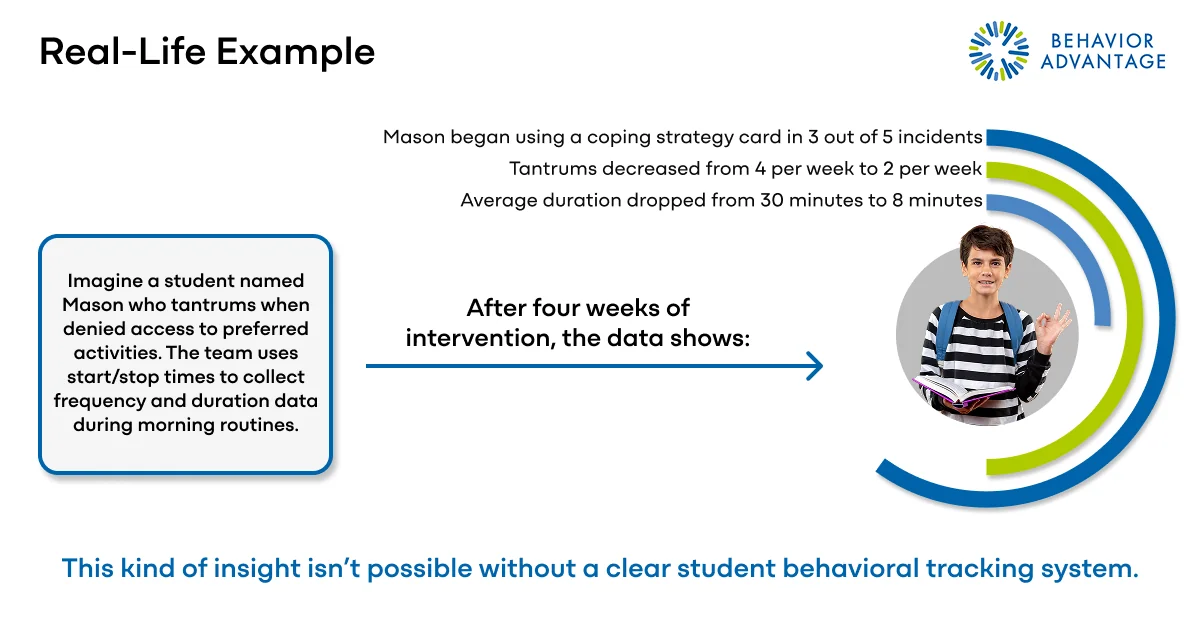In today’s classrooms, teachers and support staff juggle countless responsibilities—academic instruction, classroom management, student safety, and social-emotional development. Amid all of this, tracking student behavior can feel overwhelming. But without a clear, consistent student behavioral tracking system, educators risk missing crucial trends, abandoning effective interventions too early, or sticking with strategies that aren’t working.
In this article, we’ll show you how to build a student behavioral tracking system that’s practical, efficient, and transformative. Whether you’re just starting or looking to improve your current process, this guide offers a step-by-step approach that supports student growth and informs team decisions.
Download Our Sample Behavior Tracking Form
![]()
Why Track Student Behavior?
Behavior often changes slowly and inconsistently. Like a student learning to read, behavior progress can be bumpy—some days better than others. So how do we know if a student is truly making progress? We collect and analyze behavior data over time.
Without consistent data, we might misinterpret a single bad day as proof that an intervention isn’t working—or miss early signs that it is. A robust tracking system gives educators an objective lens, ensuring that decisions are based on patterns, not perceptions.
If you are curious about the benefits, download our free Sample Behavior Tracking Form to see for yourself!
![]()
Step 1: Choose the Right Behaviors to Track
Rarely does a student display only one behavior challenge. That’s why the first step to developing a student behavioral tracking system is to prioritize and/or group behaviors.
- Prioritize: Which behavior, if improved, would have the greatest impact on classroom participation or peer interaction? For example, if a student engages in both defiance and aggression, you might prioritize aggression because it presents a higher safety risk.
- Group: Some behaviors occur together for the same reason (e.g., avoiding academic work). You can group ignoring, whining, and leaving the room under a label like “Work Refusal.”
Whichever path you take, define behaviors in specific and observable terms. Avoid vague labels like “disrespect” or “inappropriate behavior.” Instead, clarify what these terms mean—for example, “blurting out,” “arguing,” or “leaving seat without permission.” This ensures everyone on the team collects data consistently.
Step 2: Decide When and Where to Collect Data
You don’t need to track behaviors all day long. The best student behavioral tracking systems are sustainable.
Ask yourself:
- When and where do the behaviors most often occur?
- When are new interventions being introduced?
- What part of the day is most practical for consistent data collection?
For instance, if behaviors escalate during math instruction or right after lunch, prioritize those periods. Keep your data collection window consistent—same time of day, same class period, same length of time—so you can make valid comparisons over time.
Step 3: Establish a Baseline
Before launching a new intervention, it’s ideal to collect baseline data—a snapshot of current behavior trends without supports in place. Baseline data helps you determine if new strategies are making a measurable difference.
If collecting baseline data isn’t safe or feasible (e.g., behaviors are severe), you can begin intervention right away. Just ensure you collect consistent data from the start so you can track progress over time.
Step 4: Select Practical Tools for Data Collection
Your tools should be:
- Easy to use
- Quick to fill out
- Aligned with your behavior definitions
Common Behavior Data Tools:
- Frequency tracking: Count how often a behavior occurs (e.g., 5 instances of yelling in 3rd period).
- Duration tracking: Record how long a behavior lasts (e.g., tantrum lasted 22 minutes).
- Start/Stop timing: Write down the start and end times of behavioral episodes to calculate both frequency and duration.
- Rating scales: Use a Likert-style scale to rate the intensity of a behavior or skill after a class or day.
Example:
The key is to be consistent. If you’re using a frequency count per class period, stick with that format over time. Don’t measure in periods one week and whole days the next.
Step 5: Digitize Your Student Behavioral Tracking System
Digital tools simplify the process and make behavior data easier to share, analyze, and act upon. Teachers can enter data in real-time on mobile devices or laptops, while systems like Behavior Advantage automatically graph trends.
Digital systems allow you to:
- Log data from multiple team members
- Track location, time of day, and context
- Graph data to see patterns over weeks or months
- Export reports for team meetings or IEP reviews
- Maintain FERPA and HIPAA compliance
Free options like Google Forms, editable PDFs, or Google Sheets can also be customized for simple data entry and analysis.
Step 6: Analyze and Use the Data
Collecting behavior data is only half the battle. To make the data meaningful, it needs to be analyzed and visualized.
Graphs—like line graphs or bar charts—make it easier to answer questions like:
- Is the behavior decreasing in frequency?
- Are episodes becoming shorter?
- Are replacement skills increasing?
Use graphs to guide team discussions and determine if the current plan is working—or if adjustments are needed.
For example:
“Derek is still having 2–3 tantrums a day, but the data shows they now last only 5–10 minutes instead of an hour. That tells us the intervention is helping him recover faster.”
Visual analysis helps teams recognize trends, make decisions, and celebrate small wins that might otherwise go unnoticed.

Final Thoughts
Building a student behavioral tracking system doesn’t have to be complicated. By selecting the right behaviors to track, collecting practical data consistently, and visualizing trends, educators can make smarter decisions that lead to real student growth.
If you’re looking for a behavior tracking solution that’s easy to use and designed by behavior experts, Behavior Advantage can help your team get started today.









